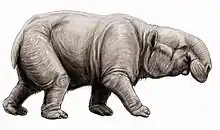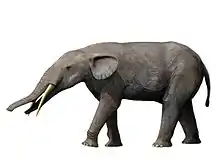Palaeomastodon
Palaeomastodon ("ancient mastodon") is an extinct genus within the elephant order Proboscidea. Its fossils have been extracted from Oligocene strata conventionally dated to 33.9-23.03 million years old. Usually considered an ancestor or near-ancestor of elephants or mastodons,[1] it lived in marshes and fluvial-deltaic environments of what is now Egypt, Ethiopia, Libya, and Saudi Arabia.
| Palaeomastodon Temporal range: Oligocene, | |
|---|---|
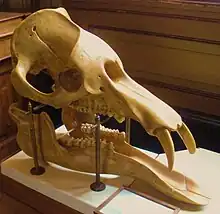 | |
| P. beadnelli skull | |
| Scientific classification | |
| Domain: | Eukaryota |
| Kingdom: | Animalia |
| Phylum: | Chordata |
| Class: | Mammalia |
| Order: | Proboscidea |
| Family: | †Palaeomastodontidae |
| Genus: | †Palaeomastodon Andrews, 1901 |
| Type species | |
| †Palaeomastodon beadnelli Andrews, 1901 | |
| Species | |
| |
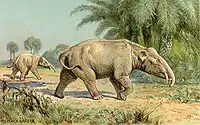
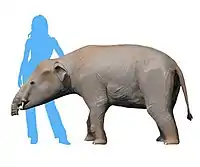

Few postcranial remains are known, but based on the reported 875 mm length of one P. beadnelli femur, a recent study estimated an adult shoulder height of about 2.2 metres (7.2 ft) with a mass over 2.5 tonnes (2.8 short tons).[2]
Palaeomastodonts possessed both maxillary and mandibular tusks. The mandibular tusks projected anteriorly and were generally flat and scoop-like. They were probably used to scrape the bark off trees and uproot various plants. By contrast, the sharp maxillary tusks primarily functioned as defensive weapons.[3]
The form, size, and capabilities of palaeomastodont nasal structures have long been debated. Though often depicted with a relatively small, prehensile proboscis, Osborn 1909 argued that wear patterns on the lower tusks better favored the presence of a large, retractile upper lip.
References
- The genus Palaeomastodon Archived 2008-10-17 at the Wayback Machine
- Larramendi, A. (2016). "Shoulder height, body mass and shape of proboscideans" (PDF). Acta Palaeontologica Polonica. 61. doi:10.4202/app.00136.2014.
- Osborn, H. F. (1909). "The Feeding Habits of Mœritherium and Palæomastodon". Nature. 81 (2074): 139–140. doi:10.1038/081139a0.
